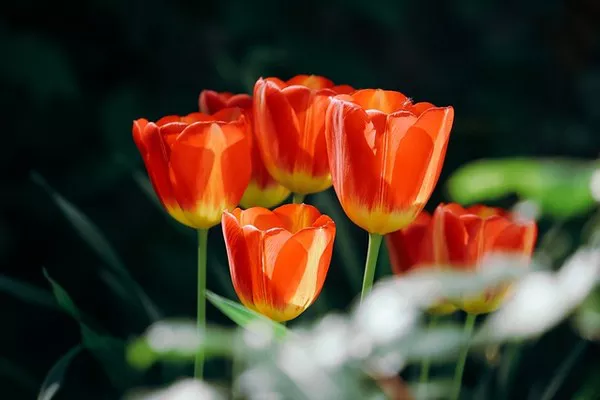Tulips, with their vibrant hues and elegant petals, have captivated the human imagination for centuries. While often celebrated for their aesthetic appeal, these flowers hold a myriad of uses beyond mere ornamentation. This article delves into the multifaceted world of tulips, uncovering their historical significance, cultural importance, and surprising practical applications that extend far beyond their visual allure.
Historical Significance:
The tulip’s journey through history is a fascinating tale of trade, exploration, and cultural exchange. Originating in the Ottoman Empire, tulips found their way to Western Europe in the 16th century, sparking a phenomenon known as “Tulip Mania.” The tulip’s popularity soared to unprecedented levels, leading to a speculative frenzy in the Dutch Republic, where tulip bulbs were traded at exorbitant prices.
Despite the economic bubble bursting, the tulip continued to thrive as a symbol of luxury, refinement, and prosperity. Today, the flower remains deeply ingrained in various cultures, symbolizing love, elegance, and the transient nature of life.
Cultural Significance:
Tulips have become cultural ambassadors, representing different sentiments across various societies. In the Netherlands, for instance, tulips are synonymous with national identity and pride. The country’s iconic tulip fields attract millions of tourists annually, and the vibrant blooms are prominently featured in Dutch art and literature.
In Turkey, the tulip holds cultural significance dating back to the Ottoman Empire, where it was embraced as a symbol of divine beauty. Tulip motifs are prevalent in Turkish art, architecture, and textiles, showcasing the enduring impact of this flower on the nation’s cultural heritage.
Tulips in Art and Literature:
The tulip’s beauty has inspired artists and writers throughout the ages. From the still-life paintings of the Dutch Golden Age to the poetry of the Ottoman era, tulips have been a recurring motif in creative expressions. Their graceful form and vivid colors continue to captivate the imagination, serving as muses for countless works of art and literature.
Beyond their symbolic representation, tulips have been celebrated for their intrinsic aesthetic qualities. Artists such as Vincent van Gogh and Claude Monet immortalized tulip fields in their masterpieces, capturing the ephemeral beauty of these flowers.
Practical Uses:
While tulips are commonly associated with ornamental purposes, their utility extends far beyond the realms of aesthetics. From culinary applications to medicinal properties, tulips offer surprising practical uses that may not be immediately apparent.
Culinary Delights:
Tulip petals are not merely a feast for the eyes; they can also be a delight for the palate. In certain cuisines, tulip petals are used as edible garnishes in salads, desserts, and even main dishes. The mild, slightly sweet flavor of tulip petals adds a unique touch to culinary creations, introducing a subtle floral note that enhances the overall dining experience.
Beyond their use in the kitchen, tulip bulbs themselves are edible and have been consumed in various cultures throughout history. Rich in nutrients such as vitamin C, potassium, and fiber, tulip bulbs can be a valuable addition to a diverse and nutritious diet. However, it’s crucial to note that not all tulip varieties are edible, and proper identification is essential to avoid toxicity.
Medicinal Properties:
Traditional medicine has also recognized the therapeutic potential of tulips. In certain cultures, tulip extracts have been used for their anti-inflammatory and antioxidant properties. The bulbs, in particular, contain compounds that may have medicinal benefits, including the potential to boost the immune system and support overall health.
While modern medicine has not fully embraced tulips as a mainstream therapeutic resource, ongoing research continues to explore their potential applications. Tulips may play a role in future pharmaceutical developments, offering new avenues for treatment and well-being.
Textile Dye and Fragrance:
Beyond the kitchen and medicine cabinet, tulips contribute to the world of textiles. The petals of certain tulip varieties can be used as a natural dye, imparting subtle hues to fabrics. This eco-friendly alternative to synthetic dyes aligns with the growing interest in sustainable and environmentally conscious practices within the textile industry.
Additionally, tulips boast a delicate fragrance that can be extracted and used in perfumery. The subtle and floral notes of tulip essence add complexity to fragrances, providing a natural and sophisticated alternative to synthetic scents.
Environmental Impact:
Tulips, with their bulbous roots and vibrant blossoms, also play a role in environmental sustainability. As perennial plants, tulips return year after year, requiring minimal maintenance once established. This characteristic makes them an eco-friendly choice for landscaping and gardening, contributing to sustainable practices in horticulture.
Furthermore, the cultivation of tulips can have positive effects on biodiversity. Tulip fields provide habitats for pollinators such as bees and butterflies, supporting local ecosystems. The responsible cultivation of tulips, with a focus on organic and pesticide-free practices, enhances their ecological impact, aligning with the global push for sustainable agriculture.
Conclusion
In conclusion, tulips are not just beautiful flowers adorning gardens and floral arrangements; they are cultural symbols, historical artifacts, and surprisingly versatile resources. From their humble beginnings in the Ottoman Empire to the economic highs and lows of Tulip Mania in the Dutch Republic, tulips have journeyed through time, leaving an indelible mark on human culture and society.
Beyond their symbolic value, tulips have proven to be more than just a visual delight. With applications in cuisine, medicine, textiles, and environmental sustainability, tulips showcase the intersection of beauty and utility. As we continue to explore the potential of nature’s treasures, the tulip stands as a testament to the diverse and valuable contributions that flowers can make to our lives. So, the next time you admire a bed of tulips in full bloom, remember that their significance goes far beyond their captivating appearance, unlocking a world of possibilities that stretch across history, culture, and practical applications.


